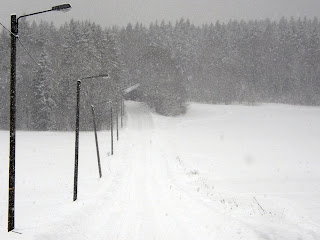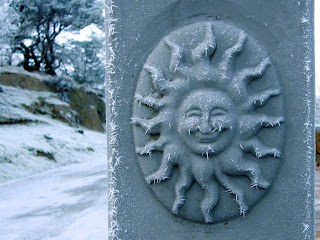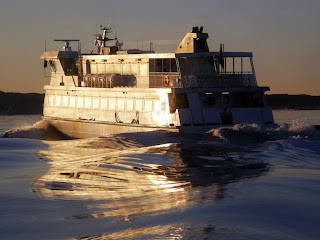Winter

This entry has been in the planning for weeks now, so long, in fact that in any country closer to the equator, winter has long turned to spring. Fortunately (well, depending how you look at it) winter is still very palpable up here in the north. Last week my wife and I spent a happy few days away visiting our old haunts up in Sundsvall on Sweden’s north east coast, and there the snow was piled high.
Sundsvall is a bit out of the geographical reach of this blog, but actually has a number of historical connections with Gothenburg which allow me to feel happy including some talk about the town, and some pictures taken up there last week. First of all, Sundsvall was founded by the same king who founded Gothenburg (Gustaf II Adolf – the Gustavus Adolphus of English language history books). Then Sundsvall’s industrial development in the late 1800s was stimulated by many of the same Anglo-Scot-Swedish families that first built their fortunes in Gothenburg (the Dickson’s in particular).

And then, of course, we lived up there for ten years, moving to Sundsvall from Gothenburg in 1987 and back to Gothenburg again in 1998.
But to get back to the Gothenburg and the west coast, winter here has been marked by some very variable weather. We have had some snow, but not really enough to get excited about. What we’ve had instead are cold snaps that have taken the temperature down well below freezing, often quite quickly.
Being a coastal city and built around a sizeable river, Gothenburg has a generally mild, and often damp climate. When I first moved back here after the 10 years or so in Sundsvall, I was enchanted by the sound of the rain falling. You don’t have a lot of that up in Sundsvall which has a relatively dry climate for all that it faces the Gulf of Bothnia. Of course Gothenburgers did think I was a bit daft when I told them how much I was enjoying the sound of rain … and of course my enjoyment wore off after about six months of unremitting rainfall.
The point I’m trying to make here is that a damp climate, especially one in which a snow fall is followed by a temperature rise be it ever so slight, tends to fill the city with mists and fogs. When these coincide with a snap temperature drop, the result is hoarfrost. This winter I’ve not seen the most dramatic hoarfrost of my life (I can remember winter days with much thicker, longer spikes of frost), but it’s been pretty dramatic even so. Sufficient to get me out and about with the camera as soon as there’s a suggestion of the sun breaking through.

Our local park, Keiller’s Park, is a happy hunting ground on these days, but even just leaning out my window can make me cheerful about what I can catch in my viewfinder.

The whole extended family spent Christmas with my brother and sister-in-law out at Tjuvkil near Marstrand. A wonderful spot. They were house-sitting for friends who were otherwise engaged. (Conducting a tiger safari in India I think it was!) The house in question is a youth hostel/b&b in the summer months, but was unbooked now, so we took it over. My godson Victor is 6 going on 7, and now highly suspicious of the existence of Santa Clause.
Now, in Swedish houses, Santa (or Tomten as he’s called) is actually expected to put in an appearance, and this year was no exception. The knock came at the door in the early evening of Christmas Eve (as it should do by Swedish tradition). The Old Man – or the Anthropomorphic Personification if you prefer – was welcomed into the warm and ushered into the living room where the presents (earlier concealed by a curtain) were now to be found.

Victor was quite convinced that our Tomte was not the real Tomte. Everyone else in the house, though, doggedly stuck to the fiction, asking after the reindeer, offering a glass of something and a bowl of rice porridge, thanking the Tomte for including us in his busy day, and eventually poor Victor started to doubt his own convictions. Next year will be more difficult, I suppose. He was happy enough with his presents, though.
The night was cold and dark – we were far enough away from the lights of the city to see something of the stars. Not like being out at sea, of course, but still. There was Orion and there was the Great Dipper – the only two constellations I can identify with confidence – and there was the Moon and Venus so the heavens were in order and all was right with the world.
The weather was cold at Christmas, a few degrees below freezing, and there was ice on puddles and fringing the rocks in fresh water lakes, but the sea hadn’t frozen yet. That came a few days later, just after New Year.
On the 5th January we decided to wrap up warm, take our cameras and visit the southern archipelago. The Swedish word for archipelago is skjärgård (say “sharegourd”) which sounds less high-faulting. In origin it’s the same word as English “skerry”, and though there are plenty of low-lying boulders and jagged rocks which tear up the sea (and tear the bottoms out of unwary boats), there are also plenty of little islands, so you can’t call them skerries. Not in my opinion anyway. So we’re stuck with archipelago – like it or lump it.

Gothenburg has two archipelagos, one lying north of the river mouth and reaching up towards the islands of the Bohus coast, the other lying to the south, stretching down towards Halland. For reasons I’ve never bothered to explore, while the northern archipelago is its own administrative area, the southern archipelago is a part of the Gothenburg municipality. This has the distinct advantage that you can travel 90 minutes out to the farthest of the islands on the public ferry transports for the same flat rate fare you would otherwise pay for a ten minute trip into the town.
Of course, you have to pay again to get back home, but it still feels like very good value.
We took tram number 11 out to the harbour at Saltholmen and then the Vrångö ferry all the way out passed Styrsö and Donsö. (The Swedish word for island is ö.)

Bitterly cold. We could only manage to stand up on deck (gloves off to operate the camera) for about 10 minutes at a time. The cameras also became sluggish after a while, I suppose rechargeable batteries don’t manage so well at those temperatures. (Certainly my mobile phone went into hibernation!)
The sun was incredible, bathing everything in this golden, almost syrupy light. It looked like it ought to be warm, but it was not. And the sea was also somehow syrupy. Thick.
There was almost no wind, except the wind the ferry made passing, so the water was unruffled except by our wake, and the wake itself didn’t seem to churn up the surface of the water nearly as much as usual. The water settled quickly back into unbroken billows that reflected the sunlight, passing ships, islands, distorting them as in the mirrors of a funfair.

It was a cold journey, a Cold Journey to the South as I wrote in my photblog, but very beautiful, uplifting.
I could write more, but I think I’ll stop there. This blog has become somewhat irregular, but I shall continue with it from time to time. If you want a more frequent update on my doings, gentle reader, look at my photoblog (mentioned above) or at my more-or-less weekly musing on the art and discipline of writing At the Quill. You are also welcome to visit my new home page where I’m trying to tie together and link up my disparate Internet personas. The home page addres is www.thesupercargo.com
Välkommen!


